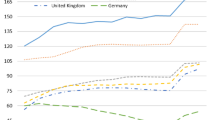Abstract
The use of GDP as the main index of progress and welfare of a country has been the subject of a long debate among economists. Using and extending the savers-spenders theory, we analyse the theoretical relationship between GDP and the welfare of a society. This analysis is undertaken using several different overlap** generations models which all take into account the great heterogeneity of consumer behaviour observed in the data (different labour supply choices, different degrees of altruism and/or different degrees of impatience to consume). The results indicate that GDP (per capita) is often a relevant index and is always a decent social welfare indicator.
Similar content being viewed by others
References
Alonso-Carrera, J., J. Caballé and X. Raurich (2005) “Growth, Habit Formation, and Catching-up with the Joneses”, European Economic Review, Vol. 49, pp. 1665–1691.
Asheim, G. and M. Weitzman (2001) “Does NNP Growth Indicate Welfare Improvement?”, Economics Letters, Vol. 73, pp. 233–239.
Baker, L. (1999) “Real Wealth - Use of Gross Domestic Product Figures as Economic Indicator May No Longer Be Valid”, E/The Environmental Magazine, May.
Barro, R (1974) “Are Government Bonds Net Wealth?”, Journal of Political Economy, Vol. 82, pp. 1095–1117.
Becker, G (1981) A Treatise on the Family, Cambridge: Harvard University Press.
— (1996) Accounting for Tastes, Cambridge: Harvard University Press.
Berman, E. and Z. Rzakhanov (2000) “Fertility, Migration and Altruism”, NBER Working Paper, No. 7545.
Borjas, G. J. (1994) “The Economics of Immigration”, Journal of Economic Literature, Vol. 32, pp. 1667–1717.
Carroll, C. D., B. K. Rhee and C. Rhee (1999) “Does Cultural Origin Affect Saving Behavior? Evidence from Immigrants”, Economic Development and Cultural Change, Vol. 48, pp. 33–50.
Cazzavillan, G. and P. Pintus (2004) “Robustness of Multiple Equilibria in OLG Economies”, Review of Economic Dynamics, Vol. 7, pp. 456–475.
Chiswick, B. (1978) “The Effect of Americanization on the Earnings of Foreign-born Men”, Journal of Political Economy, Vol. 86, pp. 897–921.
Dasgupta, S. and T. Mitra (1999) “On the Welfare Significance of National Product for Economic Growth and Sustainable Development”, Japanese Economic Review, Vol. 50, pp. 422–442.
De Nardi, M. (2004) “Wealth Inequality and Intergenerational Links”, Review of Economic Studies, Vol. 71, pp. 743–768.
Diamond, P. A. (1965) “National Debt in a Neoclassical Growth Model”, American Economic Review, Vol. 55, pp. 1126–1150.
Drazen, A. (1978) “Government Debt, Human Capital, and Bequests in a Life Cycle Model”, Journal of Political Economy, Vol. 86, pp. 505–516.
Durkin, J. T. (1998) “Immigration, Assimilation and Growth”, Journal of Population Economics, Vol. 11, pp. 273–291.
Galor, O. (1986) “Time Preference and International Labor Migration”, Journal of Economic Theory, Vol. 38, pp. 1–20.
Gaumont, D. and A. Mesnard (2000) “Altruism and International Labour Migration”, Journal of Population Economics, Vol. 13, pp. 113–126.
Laitner, J. (2001) “Secular Changes in Wealth Inequality and Inheritance”, Economic Journal, Vol. 111, pp. 691–721.
Lambrecht, S., Ph Michel and J. P. Vidal (2005) “Public Pensions and Growth”, European Economic Review, Vol. 49, pp. 1261–1281.
Lucas, R and L. Rap** (1969) “Real Wages, Employment and Inflation”, Journal of Political Economy, Vol. 77, pp. 721–754.
Mankiw, G. (2000) “The Savers-Spenders Theory of Fiscal Policy”, American Economic Review, Vol. 90, pp. 120–125.
Michel, Ph and P. Pestieau (1998) “Fiscal Policy in a Growth Model with Both Altruistic and Non-Altruistic Agents”, Southern Economic Journal, Vol. 64, pp. 682–697.
— and — (2005) “Fiscal Policy with Agents Differing in Altruism and Ability”, Economica, Vol. 72, pp. 121–135.
—, — and J. P. Vidal (1998) “Labor Migration and Redistribution with Alternative Assimilation Policies: the Small Economy Case”, Regional Science and Urban Economics, Vol. 28, pp. 363–377.
—, E. Thibault and J. P. Vidal (2006) “Intergenerational Altruism and Neoclassical Growth Models”, Handbook of the Economics of Giving, Reciprocity and Altruism, Elsevier-North Holland, Chapter 15 (Vol. 2), pp. 1055–1106.
OECD (2014) “Is Migration Good for the Economy?”, Migration Policy Debates, No. 2.
Pestieau, P. and E. Thibault (2012) “Love thy Children or Money - Reflections on Debt Neutrality and Estate Taxation”, Economic Theory, Vol. 50, pp. 31–57.
Ramsey, F. P. (1928) “A Mathematical Theory of Saving”, Economic Journal, Vol. 38, pp. 543–559.
Rangazas, P. (1991) “Human Capital Investment in Wealth-Constrained Families with Two-Sided Altruism”, Economics Letters, Vol. 35, pp. 137–141.
Samuelson, P. A. (1958) “An Exact Consumption-Loan Model of Interest With and Without the Social Contrivance of Money”, Journal of Political Economy, Vol. 66, pp. 467–482.
Sen, A. (1979) “The Welfare Basis of Real Income. Comparisons: A Survey”, Journal of Economic Literature, Vol. 17, pp. 1–45.
Smetters, K. (1999) “Ricardian Equivalence: Long-Run Leviathan”, Journal of Public Economics, Vol. 73, pp. 395–421.
Tcha, M. J. (1995a) “Altruism, Conflict and the Migration Decision”, International Regional Science Review, Vol. 18, pp. 289–312.
— (1995b) “Altruism, Household Size and Migration”, Economics Letters, Vol. 49, pp. 441–445.
— (1996) “Altruism and Migration: Evidence from Korea and United States”, Economic Development and Cultural Change, Vol. 44, pp. 859–878.
Thibault, E. (2001) “Labor Immigration and Long-Run Welfare in a Growth Model with Heterogenous Agents and Endogenous Labor Supply”, Journal of Population Economics, Vol. 14, pp. 391–407.
— (2005) “Existence and Specific Characters of Rentiers: A Savers-Spenders Theory Approach”, Economic Theory, Vol. 25, pp. 401–419.
Weil, P. (1987) “Love thy Children. Reflections on the Barro Debt Neutrality Theorem”, Journal of Monetary Economics, Vol. 19, pp. 377–391.
Weitzman, M. (1976) “On the Welfare Significance of National Product in a Dynamic Economy”, Quarterly Journal of Economics, Vol. 90, pp. 156–162.



